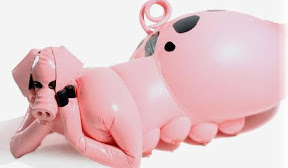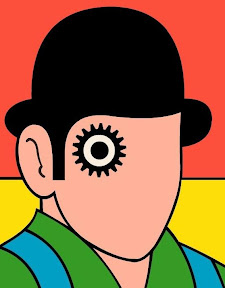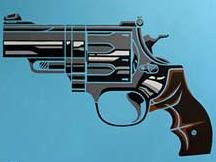Reasons to be Cheerful (Adelita) by Paul Gorman is being released next month in the UK. It celebrates the short life of graphic artist Barney Bubbles who helped design the covers and imagery of many Hawkwind albums including Space Ritual and the definitive In Search of Space.Bubbles also designed graphics that Hawkwind used in their concerts. But Bubbles worked with many other British acts, and the title of Gorman’s book relates to the iconic Ian Drury and the Blockheads single of the same name.
It seems Bubbles made the transition from Hawkwind’s brand of SF Heavy Metal to the raw pulse of the emerging British Punk rock scene, reports The Sunday Times:Soon Bubbles was designing record covers for Hawkwind, an explosion of ideas that pushed their freeform space-rock into a new dimension. The 1971 classic X in Search of Space, which unfolded into the shape of a cruciform hawk, was an elaborate triumph of sci-fi nouveau.“It was in the days of LSD, and I think Barney used to take the odd acid tab when he was doing the sleeves," laughs the Hawkwind co-founder Dave Brock. “You can probably see the results of that in his artwork, like Space Ritual.” Indeed, with its sleeve panels of cosmic embryos, nipple planets and sonic waves, Space Ritual combined Bubbles’s ideas on philosophy, theatre and art.
Still he refused to sign his work, though his reputation was growing apace.
By the mid-1970s, Bubbles made the transition from hippie to punk, reshaping [New Musical Express] NME’s logo and landing a job as in-house designer at Stiff Records. His graphics gave the fledgling label a sharp, smart new identity. He created sleeves for Nick Lowe, the Damned, Ian Dury, Elvis Costello and more — many of which cleverly subverted art movements such as dada and constructivism. It was a fiercely intelligent streak he carried through to F-Beat, Radar and Go! Discs.“His sleeve work was sensational,” asserts the Stiff photographer Brian Griffin. “And his work rate was phenomenal. I never saw Barney sleep, ever.
Hit Me with Your Rhythm Stick is one of the great art pieces of the 20th century. It’s mind-blowing. I think it’s up there with a Picasso painting.”
You can see some of Bubbles’ work from Word Magazine here. However, like many creative people, Barney Bubbles was a troubled soul who tragically ended his life, here reported by Mark Paytrees at the Hawkwind fan site Starfarer:
Barney was struggling. The regular outlets for his work were drying up. He was underpaid for the work he was still doing, and a love affair crumbled around him. "I used to do this magazine with him called Y," recalls Brian Griffin. "And one day we had this argument about the rude words in the text. It was the only argument we ever had. I went round to see him and patch it up, and he'd lacerated his face with a razorblade." Nik Turner also witnessed a more desperate Barney around this time."I got a call from his girlfriend, who said,'Come round and help us, Barney's threatening everyone with a knife.' I did and he said,
'Look, I'll kill you too.' Then he threw the knife on the ground.
He was having a nervous breakdown. Soon afterwords, he committed himself to a hospital.
"But Barney never recovered. "He phoned me up on the morning he committed suicide," Griffin remembers. "He said, 'I really feel terrible.' I recall him being worried about his VAT. I said, 'Don't worry, after I've finished shooting this Echo & The Bunnymen video I'll come straight over.' I finished early, mid-afternoon, and I phoned up. But it was too late.
@mrjyn
December 9, 2008
Barney Bubbles: Reasons To Be Cheerful (July 1942 - Nov 1983 aka Colin Fulcher)
George Jones: Yabba Dabba Do (The King is Gone and So Are You) [Austin City Limits1990]
1989 or 1990 i assume is when this special aired.I grew up in Lakeland Fla 1980-1992. Yes he did drive his John Deere to the local bar and package.The older cops around then will tell ya so. He had a place off of 540A in the highlands.
George Jones: She's My Rock [World's Greatest Country Singer 1984 for Nancy Jones]
from CMA awards at the Opry house. single was a huge hit in 1984 so it was taped around that time period...i think it spent three or four weeks in the #2 spot in late 1984.
Del Reeves: 'Sajo' [Old Folks Country Christmas with Bill Anderson, Little Tater, Webb Pierce]
Del Reeves
'Sajo'
Old Folks Country Christmas
with
Webb Pierce
Bill Anderson
Little Jimmy Dickens
w/b Hank Mills
['Girl on the Billboard'] writerThis song is called 'Sajo'.
Sajo was the name of Hank Mills' dog .
(Hank was my mom's cousin)--see comment below
the return of paradox is terrible for george jones
Pravda is a loner, but Pravda acts.
Directed by Gallien Guibert
Art Direction Guy Peellaert
Produced by Guy Peellaert & Gallien Guibert
Guy Peellaert's Pravda la Survireuse from Gallien Guibert
the return of paradox is terrible for george jones
SHELLEY MANNE: THE ISOLATED PAWN AT THE MANNE-HOLE) + Checkmate
 welcome to the Manne-hole! One would hardly think that music for television would form a solid basis for improvisation, being largely incidental music meant to set scenes rather than draw in the ear. However, Johnny Williams (the same John Williams who later created memorable music for Star Wars and the Harry Potter movies) was a composer who was able to transcend the usual boundaries of the small screen to create some memorable little themes that worked quite well apart from the show.
welcome to the Manne-hole! One would hardly think that music for television would form a solid basis for improvisation, being largely incidental music meant to set scenes rather than draw in the ear. However, Johnny Williams (the same John Williams who later created memorable music for Star Wars and the Harry Potter movies) was a composer who was able to transcend the usual boundaries of the small screen to create some memorable little themes that worked quite well apart from the show.
Shelley Manne, who had previously delved into musicals for fresh ideas (his My Fair Lady is a minor classic), was able to see the possibilities in Williams' noirish themes from Checkmate, a long forgotten TV show. It certainly helps that Manne's 1961 working quintet was filled with fire-breathers like Richie Kamuca and Conte Candoli, but clearly the music simply gave the musicians the opportunity to dig into some fresh material to generate ideas. The music bears the influence of recent modal experiments (The King Swings bears more than a passing resemblance to Impressions) and Freeman, a stalwart West Coast pianist, demonstrates a knack for working within the loose framework. Other selections are based on sinister bass and prickly drumming that instantly recall numerous spy themes; the horns, in true form, dart around like criminals in the shadows. Clearly with the talent involved, this project was likely to provide some intense blowing; had this been done by anyone else, it might not have been so interesting.
1. Checkmate 2. The Isolated Pawn 3. Cyanide Touch 4. The King Swings 5. En Passant 6. Fireside Eyes 6. The Black Knight.
Personnel: Shelley Manne-drums; Conte Candoli-trumpet; Richie Kamuca-tenor sax; Russ Freeman-piano; Chuck Berghofer-bass.
Sure, he may not usurp other players in your collection, and he might not be your favorite, but I would hate for you to miss out on what he offers.
Jazz Casual. They play some really hip stuff. The second part of that video, with Shorty Rogers and his men, is also great.
CBS at Saturday 8:30 PM (60 min.)
Premiered: September 17, 1960 Last Aired: September 1, 1962
Show Category: Drama
Checkmate Inc. was a San Franciso firm who mission was to stop or "checkmate" a crime before it happened. Anthony George played Don Corey, the head of the firm, and Doug McClure (in his second series) played Jed Sills, Corey's assistant. Sebastian Cabot played a university criminology professor who served as a consultant to Checkmate. The three worked out of Corey's beautiful Nob Hill apartment which had a great view of the city.
Guest stars were always top of the line and included Lee Marvin, Claire Bloom, Terry Moore, Angie Dickinson, Susan Oliver, James Coburn, Peter Lorre, Charles Laughton, David Janssen, Jack Lord, Lloyd Bridges, Robert Lansing, Jeffrey Hunter, Dorothy Malone, Elizabeth Montgomery, and Inger Stevens.
Originally sexy Joan O'Brien was to play the Doug McClure detective role, which would have been very intriguing in 1960.
The best thing about the show were the three appealing leads and that great apartment. In the second season, when Checkmate Inc. moved to a posh office suite, it just wasn't the same.
This show was originally on CBS Saturday nights at 8:30, immediately following "Perry Mason".
Guy Peellaert's Pravda la Survireuse from Gallien Guibert
the return of paradox is terrible for george jones
Subscribe to:
Posts (Atom)






















